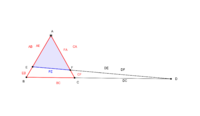Hello ...
This is a problem from Purple Comet 2014. Its intent seems to be to give students practice in using the Theorem of Menelaus.
Problem statement: The diagram below shows equilateral triangle ABC with side length 2. Point D lies on ray BC so that CD=4. Points E and F lie on AB and AC, respectively, so that E, F and D are collinear, and the area of triangle AEF is half of the area of triangle ABC. Compute AE.

I produced the diagram myself using Geogebra. I tried to attach my Geogebra file but I couldn't. This site doesn't like the extension. Anyway the only point you can move is E.
I applied the Menelaus' Theorem to triangle ABC with transversal DE. I found this:
\(\displaystyle \begin{array}{c} \frac{{\overline {AE} }}{{\overline {EB} }} \times \frac{{\overline {BD} }}{{\overline {BC} }} \times \frac{{\overline {CF} }}{{\overline {FA} }} = 1\\ \frac{{\overline {AE} }}{{\overline {EB} }} \times \frac{3}{2} \times \frac{{\overline {CF} }}{{\overline {FA} }} = 1\\ \frac{{\overline {AE} }}{{\overline {EB} }} \times \frac{{\overline {CF} }}{{\overline {FA} }} = \frac{2}{3} \end{array}\)
I also applied Menelaus' Theorem to triangle EBC with transversal AC. I learned this:
\(\displaystyle \begin{array}{c} \frac{{\overline {AE} }}{{\overline {AB} }} \times \frac{{\overline {BC} }}{{\overline {CD} }} \times \frac{{\overline {DF} }}{{\overline {FE} }} = 1\\ \frac{{\overline {AE} }}{{\overline {AB} }} \times \frac{1}{2} \times \frac{{\overline {DF} }}{{\overline {FE} }} = 1\\ \frac{{\overline {AE} }}{{\overline {AB} }} \times \frac{{\overline {DF} }}{{\overline {FE} }} = 2\\ \overline {AE} \times \frac{{\overline {DF} }}{{\overline {FE} }} = 4 \end{array}\)
Finally, we're given that the area of triangle ABC is twice that of triangle AEF. That means \(\displaystyle \overline {AE} \times \overline {AF} = 2\).
And of course we have AE plus EB =2 and also AF plus FC = 2. That makes 5 equations with 6 variables.
That's all I know. I have not been able to compute AE from that.
By the way, I do know the length of AE. It's 4/3, and the length of AF is therefore 3/2. I found that by guess work that I checked with measurements made by Geogebra. I just can't derive that number from the problem itself.
I must be missing something. Can anybody give me a hint?
This is a problem from Purple Comet 2014. Its intent seems to be to give students practice in using the Theorem of Menelaus.
Problem statement: The diagram below shows equilateral triangle ABC with side length 2. Point D lies on ray BC so that CD=4. Points E and F lie on AB and AC, respectively, so that E, F and D are collinear, and the area of triangle AEF is half of the area of triangle ABC. Compute AE.

I produced the diagram myself using Geogebra. I tried to attach my Geogebra file but I couldn't. This site doesn't like the extension. Anyway the only point you can move is E.
I applied the Menelaus' Theorem to triangle ABC with transversal DE. I found this:
\(\displaystyle \begin{array}{c} \frac{{\overline {AE} }}{{\overline {EB} }} \times \frac{{\overline {BD} }}{{\overline {BC} }} \times \frac{{\overline {CF} }}{{\overline {FA} }} = 1\\ \frac{{\overline {AE} }}{{\overline {EB} }} \times \frac{3}{2} \times \frac{{\overline {CF} }}{{\overline {FA} }} = 1\\ \frac{{\overline {AE} }}{{\overline {EB} }} \times \frac{{\overline {CF} }}{{\overline {FA} }} = \frac{2}{3} \end{array}\)
I also applied Menelaus' Theorem to triangle EBC with transversal AC. I learned this:
\(\displaystyle \begin{array}{c} \frac{{\overline {AE} }}{{\overline {AB} }} \times \frac{{\overline {BC} }}{{\overline {CD} }} \times \frac{{\overline {DF} }}{{\overline {FE} }} = 1\\ \frac{{\overline {AE} }}{{\overline {AB} }} \times \frac{1}{2} \times \frac{{\overline {DF} }}{{\overline {FE} }} = 1\\ \frac{{\overline {AE} }}{{\overline {AB} }} \times \frac{{\overline {DF} }}{{\overline {FE} }} = 2\\ \overline {AE} \times \frac{{\overline {DF} }}{{\overline {FE} }} = 4 \end{array}\)
Finally, we're given that the area of triangle ABC is twice that of triangle AEF. That means \(\displaystyle \overline {AE} \times \overline {AF} = 2\).
And of course we have AE plus EB =2 and also AF plus FC = 2. That makes 5 equations with 6 variables.
That's all I know. I have not been able to compute AE from that.
By the way, I do know the length of AE. It's 4/3, and the length of AF is therefore 3/2. I found that by guess work that I checked with measurements made by Geogebra. I just can't derive that number from the problem itself.
I must be missing something. Can anybody give me a hint?
